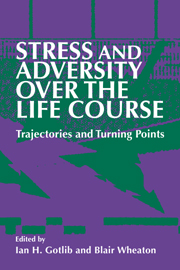Book contents
- Frontmatter
- Contents
- List of contributors
- 1 Trajectories and turning points over the life course: concepts and themes
- I Trajectories: long-term effects of adverse experience
- II Turning points: changes in life trajectories
- III New methods for the study of the life course
- 13 Construction and use of the life history calendar: reliability and validity of recall data
- 14 Using discrete-time survival analysis to study event occurrence across the life course
- Index
13 - Construction and use of the life history calendar: reliability and validity of recall data
from III - New methods for the study of the life course
Published online by Cambridge University Press: 23 October 2009
- Frontmatter
- Contents
- List of contributors
- 1 Trajectories and turning points over the life course: concepts and themes
- I Trajectories: long-term effects of adverse experience
- II Turning points: changes in life trajectories
- III New methods for the study of the life course
- 13 Construction and use of the life history calendar: reliability and validity of recall data
- 14 Using discrete-time survival analysis to study event occurrence across the life course
- Index
Summary
Introduction to the problem
The study of stress has made significant strides over the past two decades. A major current research thrust has been to construct the process of stress and distress over the life course, as evidenced in the various contributions to the present volume (see also the review by Elder, George, & Shanahan 1994). Timelagged analysis of earlier stressors on later distress allows a more confident interpretation of the causal ordering between stressors and distress. Timing and duration of events and social role changes (see Chapter 7 in this volume) – such as getting married or divorced (Chapter 9); leaving school (Chapter 10); finding or leaving jobs (Chapter 5); losing parents, children, or loved ones; experiencing combat; or natural or human disasters – may have subsequent health consequences on the individuals involved (Brown & Harris 1978; Elder 1986; George 1993; Moen, Dempster-McClain, & Williams 1992; Pearlin et al. 1981; Wheaton 1990) as well as on later generations (Elder, Caspi, & Downey 1986; Rossi & Rossi 1990; see also Chapter 6 in this volume).
The life-course approach advances the conceptual argument that similar experiences during various life stages may exert differential impacts on a person's subsequent mental and physical health. A similar event that is important at one stage in life may not be so at another stage, and vice versa. A life-course analysis of the stress-distress model is a logical and essential elaboration of the differential impact model.
- Type
- Chapter
- Information
- Stress and Adversity over the Life CourseTrajectories and Turning Points, pp. 249 - 272Publisher: Cambridge University PressPrint publication year: 1997
- 18
- Cited by



